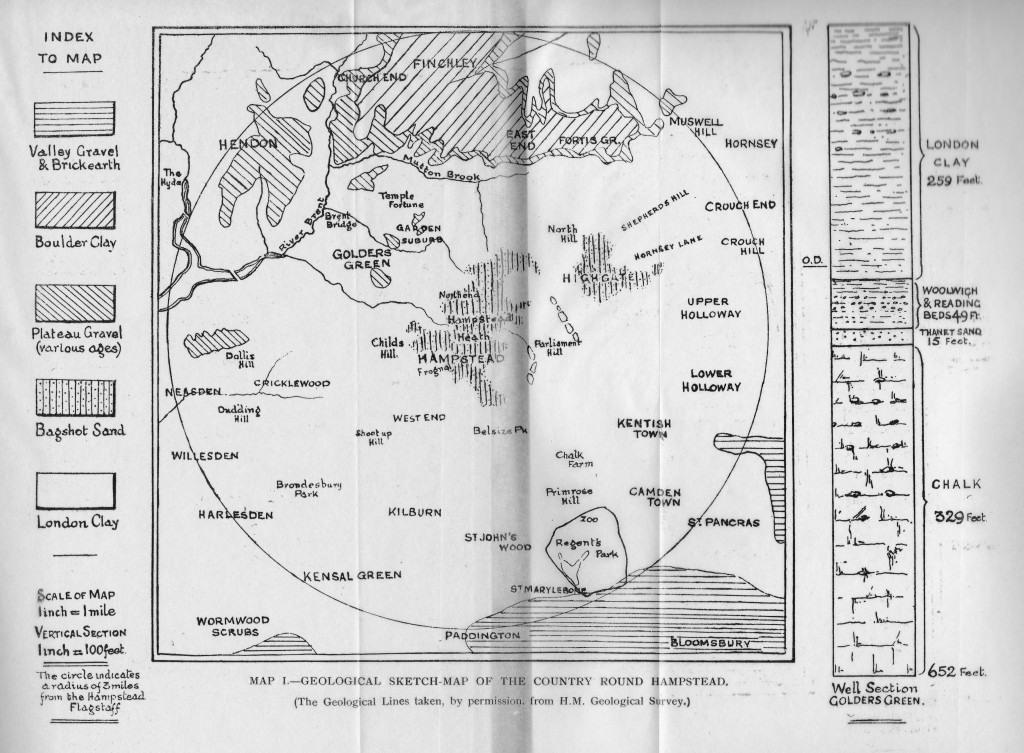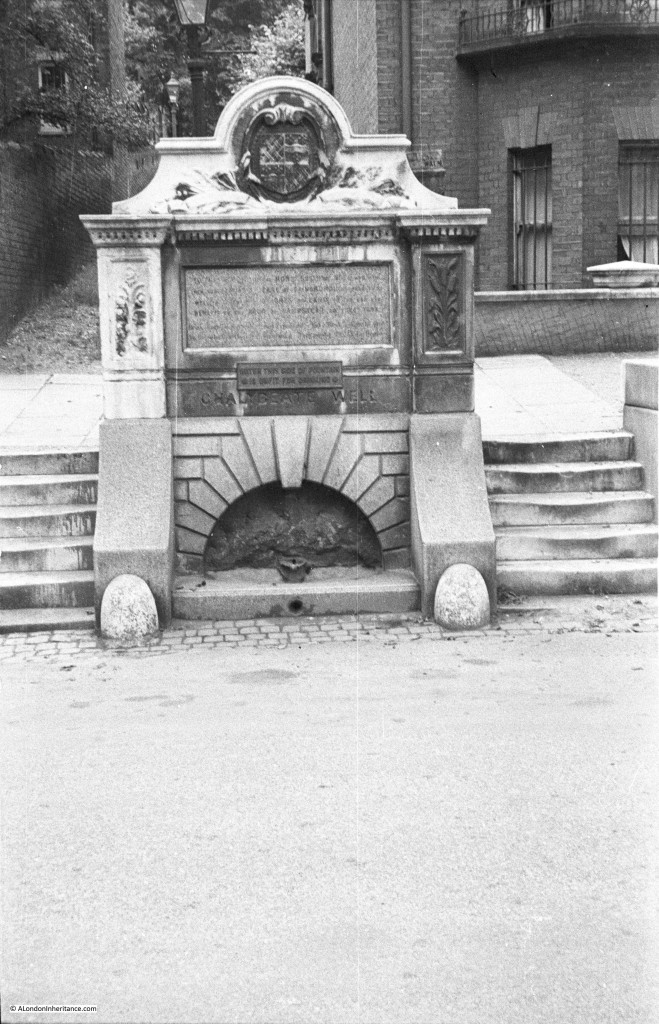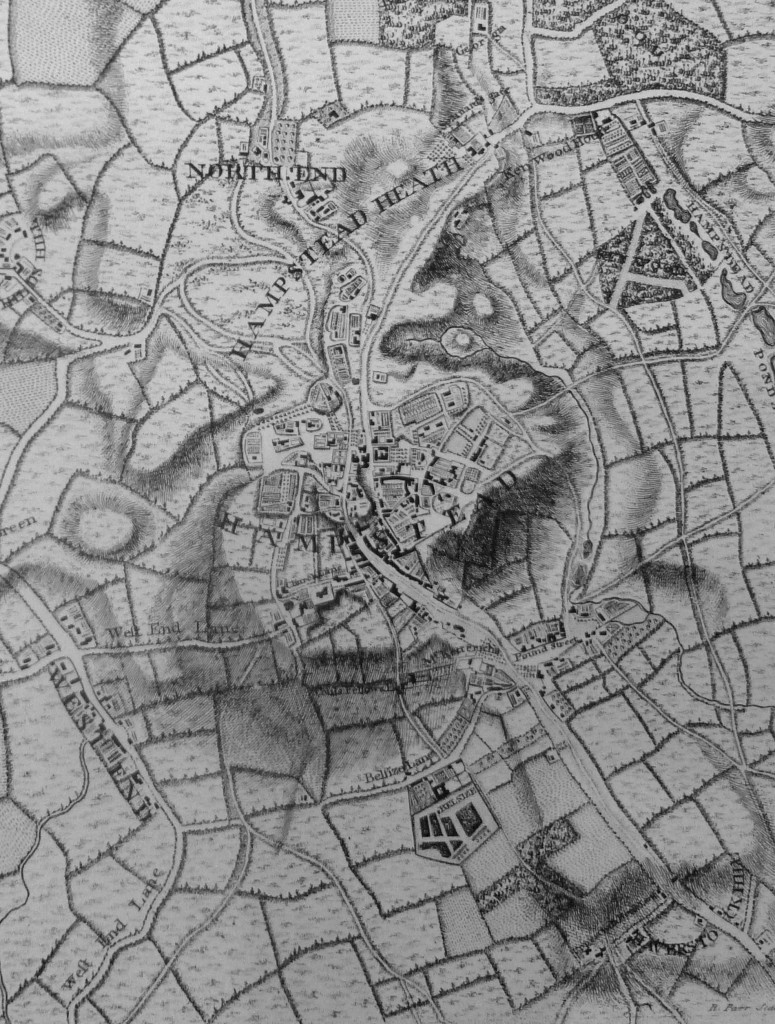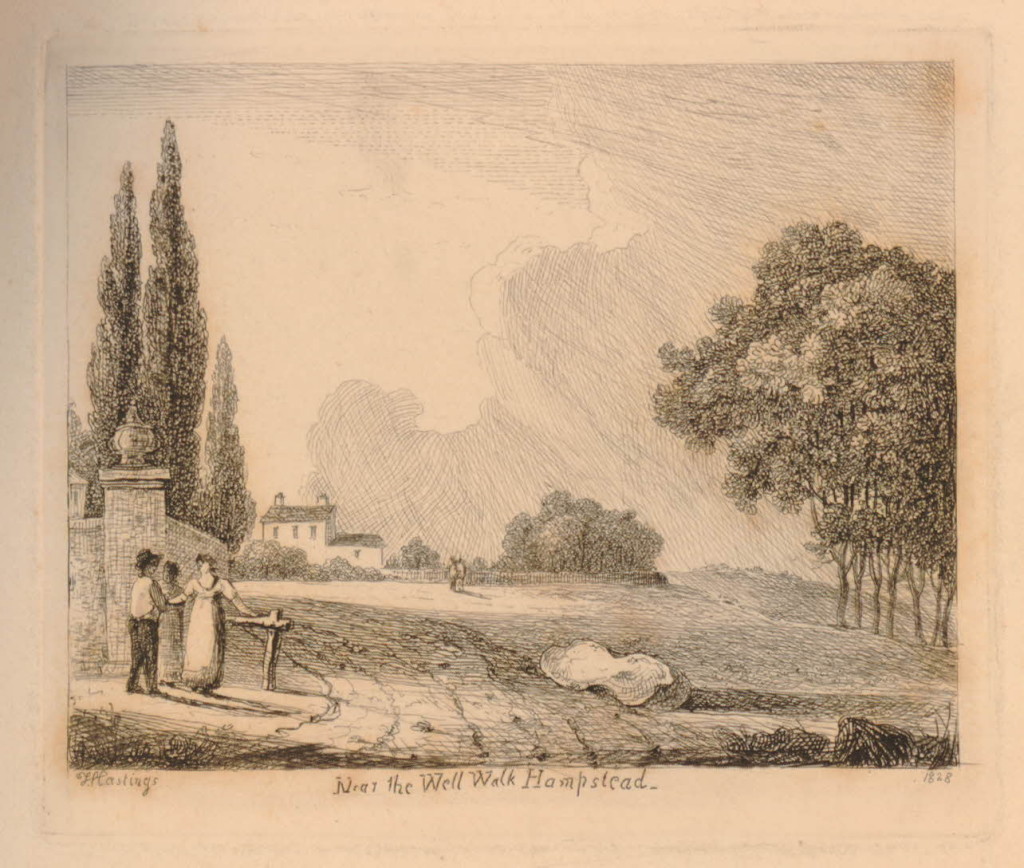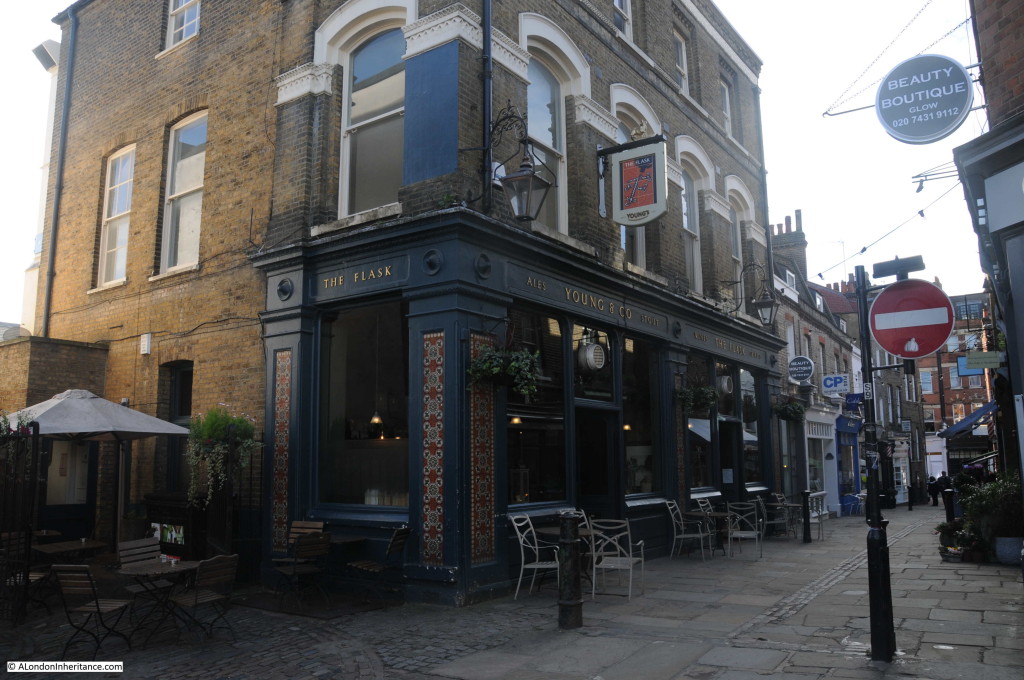The high ground of Hampstead Heath, to the north of central London has a fascinating geology which helped to drive Hampstead’s original development and is also the source of rivers such as the Fleet and the Westbourne.
The highest point on the heath reaches some 133 meters above sea level. If you stand on the heath, under your feet will be a thick layer of sand and gravel, known to Geologists as the Lower Bagshot Sands, which at the highest point is 24 meters thick. The thickness of this layer fluctuates across the heath, for example when the shafts were sunk for the Hampstead Underground Station, the layer was found to be only 5 meters thick, and the layer disappears as height descends running down from Hampstead.
Underneath the layer of sand and gravel is a layer of sandy clay which extends for 15 meters at the thickest point. Underneath this layer is the thick and impermeable London Clay which extends over much of London.
The following map from “Hampstead Heath – It’s Geology And Natural History” by the Hampstead Scientific Society published in 1913 shows the area covered by the Bagshot Sands.
Hampstead and the heath can therefore be considered as a sandy peak sitting on top of a layer of thick clay.
It is this geology which gives rise to the large number of springs which can be found across the heath. Rainwater can easily pass through the layers of sand before reaching the layer of London Clay which presents a barrier. Water then runs horizontally along the boundary between the sand and clay to come back out from the ground in the form of a spring at the point lower down the heath where the sand layer stops.
When emerging from the ground, the water carries with it the properties of the sand through which it has passed, and it is these springs and the properties of the water that have been so important in Hampstead’s development.
So what relevance does this brief geological introduction to Hampstead have to this week’s post? Among my father’s photos is this photo of a well taken in 1949:
The same well in 2016:
This is the Chalybeate Well in Well Walk, Hampstead. In the context of water, the name chalybeate means that the water contains iron.
The springs of Hampstead have a long history of providing supplies of water for the rest of London. Conduits were built to channel water from the springs along the heath to the centre of the city. During the search for sources of water, the chalybeate springs must have also been found, and whilst not suitable for drinking water, the high iron content gave rise to the believe that the water had medicinal properties.
On the 20th December 1698 the infant Earl of Gainsborough and his guardian and mother, the Countess of Gainsborough gave six acres of land in the region of the Chalybeate Well, to be used to benefit the poor of Hampstead. The deed that transferred the land refers to “the Wells lately made there for medicinal waters”. The transfer was to a charity managed by 14 trustees.
This gift of land is recorded on the plaque on the Chalybeate Well:
The land in this area of Hampstead was poor quality and rather boggy due to the number of springs. Despite the gift of the land, there was little from the land that would benefit the poor of Hampstead, apart from the springs and it is these that the trustees started to develop.
An advertisement posted by the trustees in the “Postman” on the 18th April 1700 reads:
“The Chalybeate Waters at Hampstead being of the same nature and equal in virtue with Tunbridge Wells and highly approved of by most of the eminent physicians of the College, as likewise by many of the gentry who formerly used to drink Tunbridge Waters, are by direction of the Trustees of the Wells aforesaid, for the conveniency of those who yearly drink them in London carefully bottled up in flasks and sent to Mr. Phelps Apothecary at the Eagle and Child in Fleet Street every morning at the rate of 3d per flask and if any person desires to have them brought to their own houses, they will be conveyed to them upon their leaving a note to Mr Phelps’ aforesaid at 1d more, and to prevent any person being imposed upon the true waters and nowhere else to be procured unless they are sent for to the Wells at Hampstead, and the said Mr Phelps to prevent Counterfeits hath ordered his servants to deliver to each person who comes for any of the waters aforesaid, a sealed ticket viz: a wolf rampant with 7 Crosslets. Note! the messengers that come for the waters must take care to return the flasks daily.”
So the Chalybeate Wells of Hampstead were in competition with those of Tunbridge Wells. It also provides a fascinating insight into the need to guarantee that the waters provided in flasks were original – the use of a sealed ticket with a wolf rampant sounds very dramatic.
The waters were bottled on the site of the present pub “The Flask” on Flask Walk which leads directly into Well Walk.
The source of the water that was sold in London was not from the existing Chalybeate Well in Well Walk, the source was a spring and pond (filled in about 1880) about 100 yards further up the hill.
As well as the sale of the water in London, the trustees also looked at other opportunities for how they could gain further benefit from the 6 acres of land.
On the 2nd June 1701, a John Duffield was granted possession of the land for a period of 21 years for an annual rent of £50. John Duffield must have realized the opportunities that the land and the associated springs provided with their close location to the rest of London. He immediately started building work, constructing buildings that would enhance the local springs with a Great Room or Long Room, Assembly Rooms and a Pump Room. To these rooms were soon added a tavern, chapel and shops along with formal gardens and a bowling green.
The following map from George Potter’s “Hampstead Wells” published in 1907 provides an overview of the area around 1761. The original source for the Chalybeate waters is at point C. The walkway between Well Road and Well Walk terminates on Well Walk directly behind the current Chalybeate Well so the locations of the Great Room, Pump Room etc. can be positioned along the current Well Walk.
The type of entertainments provided in these rooms can be identified from another advert in the “Postman” on the 9th September 1701:
“In the Great Room at Hampstead Wells on Monday next being the 15th, exactly at 11 o’clock of the forenoon will be performed a Consort of vocal and instrumental Musick by the best Masters, and at the request of several gentlemen, Jeremy Bowen will perform several songs and particular performance on the violin by several masters. Tickets to be had at the Wells and at St. Stephen’s Coffee House in King Street, Bloomsbury at 1s per ticket. There will be dancing in the afternoon as usual.”
A later advertisement mentions that the room will hold 500 people which gives an indication of the size, and also at 1s per ticket the amount of money that the new buildings at the Hampstead Wells were generating.
John Rocque’s map published in 1746 shows the village of Hampstead still as a village surrounded on all sides by fields and the heath. The new developments around Well Walk are to the upper right of the village.
The rear of the Chalybeate Well in 1949. On the left of the basin is a chain which presumably had a cup attached to allow the waters to be drunk from the basin.
The rear of the well in 2016. The chain and cup have disappeared. Just above the right hand-side of the basin is a modern push button which appears to offer a pump-action to bring water to the basin – I tried it several times but there was no water.
The chalybeate waters, the Long Room, Pump Room etc. enjoyed a number of years of great popularity with those who could afford to travel and pay for the entertainments, with Londoners flocking to Hampstead. However after a number of years their popularity declined, there were a number of scandals and trouble at the tavern. It was also found that the poor of Hampstead who should have benefited from the original grant of land had not received anything as John Duffield had not been paying his annual £50 rent, and by the 1720s when the situation could not last for much longer, eleven of the original fourteen trustees had died so the trust had also become rather ineffective.
After this initial development of the grant of the 6 acres of land, and the chalybeate waters, the area continued under the management of what became the Wells Charity. Continued efforts were made to promote the waters and the entertainments that were provided in the buildings along Well Walk and during the 19th century the houses that currently line Well Walk gradually replaced the 18th century buildings, constructed to promote the spring waters.
The original public basin that held the spring waters was on the opposite side of the road from the current Chalybeate Well which was built around 1882. Water has never run freely from the well. Digging of sewers in the road and other building works appears to have disrupted the underground flow of water. Even if water was flowing into the well, it would not be wise to drink.
A Dr. Atfield analysed the water from the well in 1884 and found that it contained:
There was a note at the bottom of the above table which read:
“Note – This appears to be chalybeate water mixed with ordinary surface water. If this could be excluded a purely chalybeate water would probably be obtained.”
Not that there was much to drink. In 1907, George Potter of the Wells and Campden Charity recorded that:
“The traveler requiring a draft of it would have to spend at least an hour to obtain a moderate one from this source, and when he had obtained it he probably would not relish it very much.”
So, despite the new well being constructed, there was very little water and what was available was not very drinkable.
George Potter tried to find other sources of water which could be run to the well. A number of shafts were sunk in the gardens of houses along Well Walk and spring water was found, however on analysis it was found that:
“With reference to the analyst’s report on the two samples of water, Nos 2 and 3, a copy of which I forwarded to you on the 10th, it appears to me that I cannot allow it to pass without representing to those in whom is vested the Chalybeate Spring that persons drinking this water run a serious risk of injury to their health.” (Letter from Dr. Herbert Lttlejohn, Medical Officer of Health to George Potter on the 17th November 1902.)
George Potter described his disappointment with these results: “The handsome new fountain in Well Walk, a fountain without water, is now only a monument – a monument to commemorate the memory of the departed glories of the once famous Hampstead Spa. But even now I am not without hope that a supply of this water, practically pure, may yet be found and let to this fountain – a fountain only in name at present.”
The Well Charity continues to this day in the form of the Hampstead Wells and Campden Trust. Although having been through amalgamation with other charities and changes in status, the charity is rooted in the original donation of 6 acres of land by the Earl and Countess of Gainsborough
The well provided a common source of street names in the area. Chalybeate Well is on Well Walk. Just behind the well is Well Passage which leads up to Well Road.
Well Walk has been the location for a number of drawings and paintings of Hampstead over the years. The following print being an example, and reads: “A Prospect of Hampstead from the Corner of Mrs Holford’s Garden, opposite the Well Walk” and shows Hampstead in 1745 (print by William Henry Toms)
©Trustees of the British Museum
The following print by a Captain Thomas Hasting is from 1828 and titled “Near the Well Walk Hampstead”
©Trustees of the British Museum
Hampstead has also long been the residence of artists. A blue plaque along Well Walk identifies one of the two houses in which the artist John Constable lived in Hampstead. He frequently visited Hampstead in the summer then moved there permanently until his death in Hampstead in 1837. He took the lease on the house in Well Walk from the summer of 1827 until 1834.
Constable delighted in the view of London from his house in Well Walk and worked on a number of paintings of the view. The following is a watercolor painted in the drawing-room at 6 Well Walk looking across to the City and St. Paul’s Cathedral. An inscription on the rear of the painting reads: “Hampstead. drawing Room 12.oclock noon Sept.1830”
©Trustees of the British Museum
Walking back into Hampstead, at the junction with Christchurch Hill is the Wells Tavern. This was built on the site of the original tavern, the “Old Green Man” which was pulled down in the late 1840s.
At the Hampstead end of Well Walk, the road splits into Flask Walk and Gayton Road. Follow Flask Walk towards Hampstead to find The Flask. Both the walk and the pub are named after the flasks that were filled here with spring water ready for dispatch to London.
The Chalybeate Well is a reminder of how the geology of a location has played a part in the development of London. The springs helped the early development of laundry services in Hampstead, the waters were channeled to the City through conduits and they have shaped the development and natural history of the heath.
I hope to cover this in more detail in future posts (and it provides a good excuse to walk more in Hampstead and visit Hampstead pubs).
The sources I used to research this post are:
- Springs, Streams and Spas of London by Alfred Stanley Foord published in 1910
- Hampstead Heath. Its Geology and Natural History by the Members of the Hampstead Scientific Society published in 1913
- Hampstead Wells – A Short History of their Rise and Decline by George W. Potter published in 1907
- For the poor of Hampstead for ever – 300 years of the Hampstead Wells Trust by Christopher Wade published in 1998

